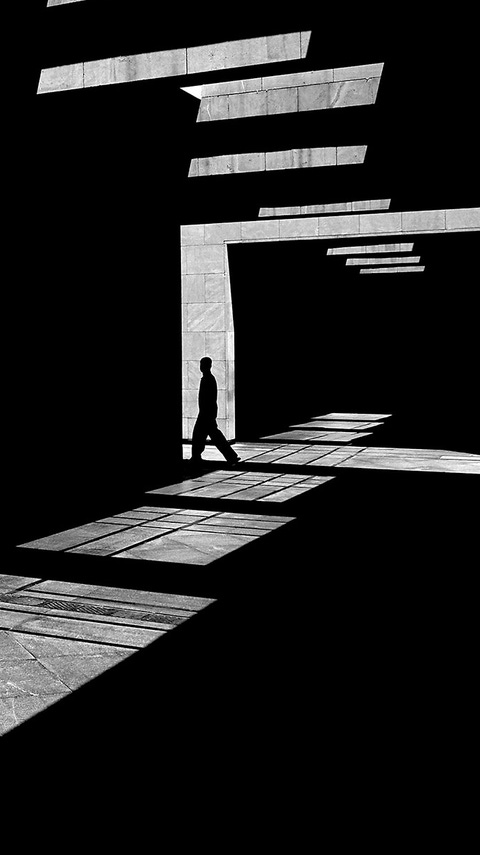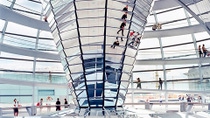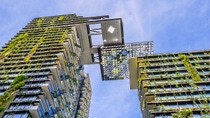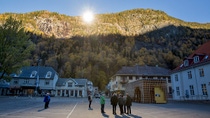Priopćenja i novosti
Let there be light
It boosts performance, brightens the mood, and even has healing powers – in correct doses, daylight is astonishingly good for humans. Experts from a wide range of fields are lighting up the darkness and building on nature as they do so.
Daylight can save lives – this is the conclusion of researchers who observed female patients in the intensive care unit of a hospital in Alberta, Canada. Those who were in a sun-drenched room survived a heart attack much more often than their fellow patients in dark rooms – and they also recovered more quickly. Admittedly, this is just one piece of the jigsaw, but the knowledge assembled over time does, bit by bit, form a consistent picture – which is that natural light has a positive effect on health and well-being.
Architecture is on the threshold of a new era in light.”
As far back as 125 years ago, Scandinavian physician Niels Ryberg Finsen treated diseases including smallpox with daylight, and this earned him the Nobel Prize for Medicine. Today, the researcher and professor of architecture Mariana Figueiro from the United States is using her light table to add to the body of knowledge. The rectangle radiating light into the room is slightly reminiscent of an oversized smartphone lying on four gleaming metal legs. In a retirement home, its glow helped Alzheimer’s patients sitting at it to become calmer, sleep better, and be less depressed.
Figueiro observes the positive effects of daylight in environments where most confounding factors are controllable, such as hospitals or retirement homes. This is much more complicated in an office environment, yet she is seeing positive results even there. “Our studies show that office workers who receive a higher amount of daylight have better sleep, and lower levels of depression and stress, than those who spend their days in bad lighting conditions,” says Figueiro, who conducts research at Rensselaer Polytechnic Institute in New York. It is, however, more difficult to prove the link between increased light exposure and improved performance, she adds.
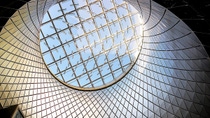
“Today, we have the technological tools for unlocking the many effects of light,” Figueiro says, adding that it is unfortunate that this resource is still so little used. According to Hamburg-based light planner and engineer Professor Peter Andres, “light is a basic foodstuff.”
At BASF, expertise on the subjects of light and energy in various specialist areas is pulled together by the architect Cristobal Garrido. Smart Daylight Management is the name of his project, similar to a startup, which is developing solutions to find the best way of managing daylight. “Thanks to new discoveries, architecture is on the threshold of a new era in light,” Garrido says. “It means that we can at last put the focus on people, and no longer on buildings.”
Lighting concepts then and now
In both ancient and modern times, architects have always had a special relationship with light.
Egyptian miracle of the sun
The ancient Egyptians planned the rock temple at Abu Simbel so that the sun’s rays would penetrate it only twice a year, for about 20 minutes. Only at the time of this miracle of the sun does light fall on three statues of gods from the 13th century BC.
Gothic light
To make church buildings transparent for the divine wisdom – this is the idea at the heart of the Gothic cathedrals of the Middle Ages. The light entering the interior through large, stained-glass windows was intended to give believers a sense of a higher reality.
Artificial lighting
Electric light was used to illuminate architecture in a big way for the first time at the 1900 Exposition Universelle in Paris, France. The Eiffel Tower was bathed in artificial light and was visible over a wide area. From then on, new building shapes that did not have to be dictated by daylight became possible.
Lighting according to biorhythm
There are three letters that are electrifying the widest possible range of lighting experts – HCL. This acronym stands for human-centric lighting – meaning lighting that is geared to the needs of the human biorhythm. There are also three factors that could help the global HCL trend make its breakthrough. The first is the discovery by American neurologists who found a receptor in the eye that is not there for seeing but controls a human’s internal clock.
This is a discovery on which researchers such as Figueiro are building – and through which they are constantly finding fresh knowledge. Second, building designers have for a long time now had the efficient management of energy by using natural resources such as daylight on their agenda. Finally, a more recent innovation is now making it possible to put these discoveries to practical effect – light-emitting diodes, or LEDs for short. These are now so far advanced that, even where there is a lack of sunlight, indoor spaces can be illuminated in a manner identical to natural light. This HCL-supporting technology could receive an additional boost from the fact that many old lamps and light fixtures have now reached the end of their natural life and need to be replaced. “Especially in public buildings, there is now often pressure to get the lighting refitted,” observes Andres, who is bringing bright light to Hamburg Airport or the entrance areas of the Alte Pinakothek art gallery in Munich, Germany.

With its glass fronts stretching up to the ceiling, Hamburg Airport, Germany, is truly full of daylight.
At the same time, light planning that is geared to human needs is no mere aesthetically pleasing feel-good project, as large residential and office buildings are now competing worldwide for investors. “Everyone wants to be out in front here,” says Garrido. This means that he and his competitors are increasingly preoccupied by human criteria. For example, do workers feel comfortable in these buildings? Is the design contributing to their productivity? A qualified architect, Garrido has little faith, aesthetically, in past solutions for bringing daylight into buildings. “They were violent interventions that either destroyed façades or limited the creative freedom of architects,” he says.
Rather than take a sledgehammer to the problem, Garrido and his BASF team are now developing finely tuned, modular light management solutions that can both be fitted on a small scale into existing buildings and installed as a complete system in new structures. The first element here is a special film on the façade with millions of tiny mirrors, and researchers like André Kostro, PhD, are now working on the best angle of inclination for these. The film needs to direct as much solar radiation as possible into the interior of a building through a light shaft.
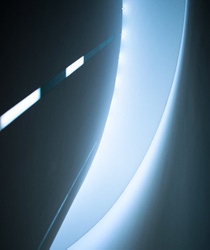
This is challenging because, on the one hand, it is essential to lose as little natural light as possible in the process, but on the other, the sky changes regularly. “With regard to the amount of light coming in, every year and every day – and even every hour – is different,” says Kostro, innovation researcher at BASF. So, too, is every building, which is why the BASF team and the Austrian lighting specialists from the company Bartenbach have calculated together how thousands of parameters – from room height to area and construction materials – affect how the system functions. The researchers are now planning to take two to six different combinations of film and match them to varying spatial and geographical conditions ranging from north Sweden to South Africa.
Mirror, mirror – in the film
Reflective film is also used on the light tubes, which direct the rays of light from outside into the depths of the building. This natural light is absorbed by what are known as luminaires, light fixtures on the ceiling, and directed into areas that are far away from windows. They are framed by LEDs that step in if there is not enough natural light. BASF’s Smart Daylight Management is intended to work with a sophisticated measuring system that is capable of learning, stores people’s individual lighting preferences and needs, and responds according to the situation.
Is this a dream of the future? Not at all. Researcher Figueiro is already experimenting with a sensor wristband that measures how much daylight the wearer receives over the course of a day – and what effect this has on their well-being. One astonishing result is that, although office workers were working in areas with light levels that meet accepted standards and recommended light levels, they were not receiving enough light to stimulate their circadian system during the day.
Light is a basic foodstuff.”
“In such cases, a personalized sensor could be helpful,” she says. “It would communicate with the lighting system at home, which would then make up for that shortfall.” However, according to Figueiro, what does not work is trying to compensate for the morning deficit by topping up with evening rays. “Light that has a stimulant effect in the morning could significantly delay sleep in the evening,” the scientist explains. For this reason, she advises against using tablets and smartphones shortly before going to bed. “Good light planning replicates the natural daylight rhythm and supplements it where necessary. It does not manipulate,” Andres says.
If you subject school students to a massive light shower when they become tired, for example, you are engaging in light doping, he says. “It is roughly the same as putting espresso in children’s school milk.” That is unacceptable, of course. “Rather,” Garrido adds, “smart light management means using the natural day/night cycle as our model.”
Three places that direct light intelligently
Smart mirror technology illuminates historic edifices, ultramodern building complexes and entire villages.
